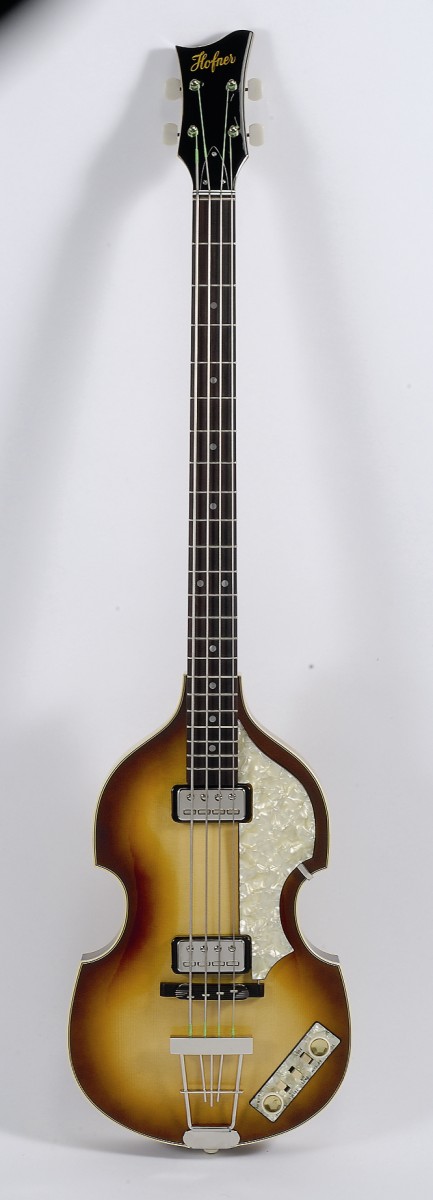MusicRadar Verdict
If you're looking for a bass with that 'wow' factor then the Violin Bass is one of the best out there: distinctive looks, feel, sound and delivery, it really has got the lot; and while it retains many of the idiosyncrasies of the original, we think this a good thing.
Pros
- +
Classic design. Balanced sound over entire board. General ‘wow’ factor.
Cons
- -
The lack of decent strap buttons will be annoying to some.
MusicRadar's got your back

Hofner 500/1 Violin Bass

Hofner 500/1 Violin Bass
One of the most distinctive designs ever conceived, the Hofner 500/1 Violin Bass still looks as good today as it did when it was first produced in 1956.
It's a shape that's been used on stringed instruments for centuries, so it's no wonder that there's a rightness about these visual elements. One of the smallest and lightest basses ever designed, yet with a full-fat sound, it's an ideal companion for the bass player on the move.
Construction and features
Although many of the appointments seem a little crude by today's standards - particularly the bridge and the guitar-sized tuning keys - they perform their respective tasks well enough, even if the tuners sometimes seem a little abrupt in operation. The bridge saddles are actually small strips of fret wire and each is embedded into one of the four slots cut into the wooden surface of the bridge block. This authentic design is functional, to say the least, and could be questioned if the tuning properties were compromised or if the natural sound of the instrument was lacking in delivery - but on both counts this bass performs particularly well.
The authenticity of this model has to be applauded. The neck proportions are comfortably meaty and quite deep, and although the body and headstock are edge-bound, the fretboard remains plain.
The tuners are ganged in pairs, sharing the same metal base strip, and only one strap button is included at the tail end (and that's made of plastic). In the early days of The Beatles, McCartney had his strap looped around the headstock, and later under the fretboard, but most players just fit an extra button at the heel of the neck. The distinctive nut is also the same as ever and has a black stripe running through it, while the fretboard is fitted with a zero fret to ensure consistent string height.
In use
If you're a regular solid-bodied bass player, the lack of overall weight is a little disconcerting at first, but once you get used to it, you appreciate just how much it adds to the comfort. Also, both of these models come fitted with flatwound strings and if you're used to round-wounds, the smoothness may going to seem strange. But it is only right, as flatwounds were always an important factor in the sound of these unique basses.
There's a degree of logic to the control panel but it's slightly bizarre. For example, turning on the bass pickup automatically turns the treble pickup off, and vice versa. Therefore whatever action you take you get an unexpected reaction. Hofner did once alter the panel so it was more logical, but users didn't appreciate the changes and the traditional wiring was reinstated in spite of the quirkiness.
As far as getting a good sound is concerned you really can't go wrong. Although the tonal range is far from expansive, there are loads of subtle changes available within the parameters. What's particularly pleasing is discovering how many of these sounds were used by the likes of McCartney and, of course, if you happen to be in a Beatles covers band, then this is absolutely essential.
MusicRadar is the number one website for music-makers of all kinds, be they guitarists, drummers, keyboard players, DJs or producers...
- GEAR: We help musicians find the best gear with top-ranking gear round-ups and high-quality, authoritative reviews by a wide team of highly experienced experts.
- TIPS: We also provide tuition, from bite-sized tips to advanced work-outs and guidance from recognised musicians and stars.
- STARS: We talk to musicians and stars about their creative processes, and the nuts and bolts of their gear and technique. We give fans an insight into the craft of music-making that no other music website can.
“Sometimes I am two people. Johnny is the nice one. Cash causes all the trouble. They fight”: How Johnny Cash drew on his own experiences to make his greatest songs
“For those on the hunt for a great quality 12-string electro-acoustic that won’t break the bank, it's a no-brainer”: Martin X Series Remastered D-X2E Brazilian 12-String review
“I have that on more records than anything else”: Take a peek inside Vaughn Oliver’s studio










